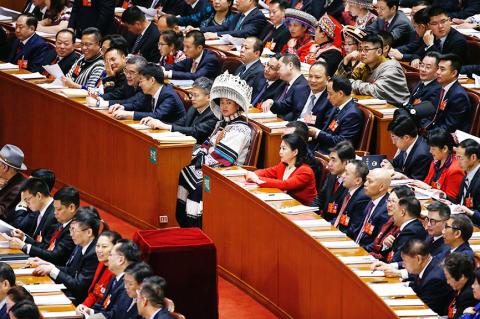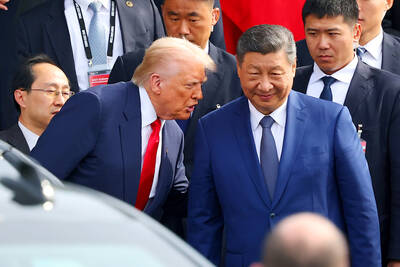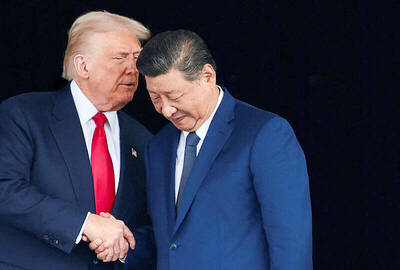China’s defense budget is to rise 8.1 percent to 1.1 trillion yuan (US$175.1 billion) this year as the nation prepares to launch its second aircraft carrier, integrate stealth fighters into its air force and field an array of advanced missiles able to attack air and sea targets at vast distances.
The figure released in a report yesterday to the 13th National People’s Congress is an increase in the growth rate from last year, when officials said the budget was rising 7 percent to 1 trillion yuan.
“We will stick to the Chinese path in strengthening our armed forces, advance all aspects of military training and war preparedness,” Chinese Premier Li Keqiang (李克強) said.

Photo: EPA
China has the world’s largest military by number of personnel, but Li said the nation had “basically completed” the target of reducing the size of the armed forces by 300,000 troops. That would leave the Chinese People’s Liberation Army’s strength at about 2 million troops.
However, China’s defense spending as a share of GDP and the budget remains lower than that of other major nations, congress spokesman Zhang Yesui (張業遂) said on Sunday.
This year’s defense budget comes to about 1.3 percent of last year’s GDP.
Analysts do not consider China’s publicly announced defense spending to be entirely accurate, since defense equipment projects account for a significant amount of “off-book” expenditures.
Noting that this year’s increase was roughly the same as last year’s when adjusted for inflation, Shanghai military expert Ni Lexiong (倪樂雄) said that China is seeking to avoid a full-on arms race based on quantity of weapons, choosing instead to invest in high-tech systems and training.
China’s defense budget is so large that double-digit annual percentage increases are no longer necessary, military commentator Song Zhongping said.
New funds are going mainly to raise living standards for service members, increase training and prepare for potential crises on the Korean Peninsula, the border with India or in the South China Sea or Taiwan Strait, Song said.
Much of China’s energies have been focused on what is known as anti-access/area denial operations, which seek to scare the US Navy and other forces far from China’s shores.
All three of China’s sea forces — the navy, coast guard and maritime militia — are the largest of their types by number of ships, allowing them to “maintain presence and influence in vital seas,” said Andrew Erickson of the US Naval War College’s China Maritime Studies Institute.
All three fleets are growing “leaner and meaner” due to a greater emphasis on technical sophistication, Erickson wrote, adding that the US also anticipates facing a Chinese submarine fleet twice its number, although less technologically advanced.
In the air, China last month said it had begun equipping combat units with its J-20 stealth fighters.
No less impressive is its missile technology, particularly the DF-21D, which is built to take out an aircraft carrier, and a new air-to-air missile with a range of about 400km that could attack assets such as early warning aircraft and refueling tankers crucial to US Air Force operations.
Meanwhile, Li said that China would never tolerate any separatist schemes for Taiwan and would safeguard its territorial integrity with the aim of “reunification.”
Li issued the warning in his speech at the congress’ opening amid mounting Chinese anger over a US bill that seeks to raise official contacts between Washington and Taipei.
China would promote the peaceful growth of relations across the Taiwan Strait and “advance China’s peaceful reunification,” Li said.
“As fellow Chinese living on both sides of the Taiwan Strait, we share a bond of kinship. As long as we go with the tide of history and work together for our nation’s greater good, we will together create the future — a beautiful future of national rejuvenation,” he added.
China would also continue to implement to the letter the “one country, two systems” method of rule for Hong Kong and Macau, Li said.
Additional reporting by Reuters

CALL FOR SUPPORT: President William Lai called on lawmakers across party lines to ensure the livelihood of Taiwanese and that national security is protected President William Lai (賴清德) yesterday called for bipartisan support for Taiwan’s investment in self-defense capabilities at the christening and launch of two coast guard vessels at CSBC Corp, Taiwan’s (台灣國際造船) shipyard in Kaohsiung. The Taipei (台北) is the fourth and final ship of the Chiayi-class offshore patrol vessels, and the Siraya (西拉雅) is the Coast Guard Administration’s (CGA) first-ever ocean patrol vessel, the government said. The Taipei is the fourth and final ship of the Chiayi-class offshore patrol vessels with a displacement of about 4,000 tonnes, Lai said. This ship class was ordered as a result of former president Tsai Ing-wen’s (蔡英文) 2018

UKRAINE, NVIDIA: The US leader said the subject of Russia’s war had come up ‘very strongly,’ while Jenson Huang was hoping that the conversation was good Chinese President Xi Jinping (習近平) and US President Donald Trump had differing takes following their meeting in Busan, South Korea, yesterday. Xi said that the two sides should complete follow-up work as soon as possible to deliver tangible results that would provide “peace of mind” to China, the US and the rest of the world, while Trump hailed the “great success” of the talks. The two discussed trade, including a deal to reduce tariffs slapped on China for its role in the fentanyl trade, as well as cooperation in ending the war in Ukraine, among other issues, but they did not mention

HOTEL HIRING: An official said that hoteliers could begin hiring migrant workers next year, but must adhere to a rule requiring a NT$2,000 salary hike for Taiwanese The government is to allow the hospitality industry to recruit mid-level migrant workers for housekeeping and three other lines of work after the Executive Yuan yesterday approved a proposal by the Ministry of Labor. A shortage of workers at hotels and accommodation facilities was discussed at a meeting of the legislature’s Transportation Committee. A 2023 survey conducted by the Tourism Administration found that Taiwan’s lodging industry was short of about 6,600 housekeeping and cleaning workers, the agency said in a report to the committee. The shortage of workers in the industry is being studied, the report said. Hotel and Lodging Division Deputy Director Cheng

‘SECRETS’: While saying China would not attack during his presidency, Donald Trump declined to say how Washington would respond if Beijing were to take military action US President Donald Trump said that China would not take military action against Taiwan while he is president, as the Chinese leaders “know the consequences.” Trump made the statement during an interview on CBS’ 60 Minutes program that aired on Sunday, a few days after his meeting with Chinese President Xi Jinping (習近平) in South Korea. “He [Xi] has openly said, and his people have openly said at meetings, ‘we would never do anything while President Trump is president,’ because they know the consequences,” Trump said in the interview. However, he repeatedly declined to say exactly how Washington would respond in